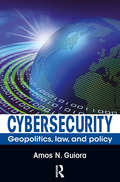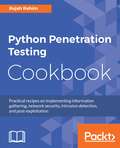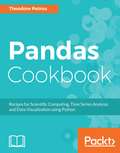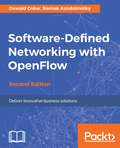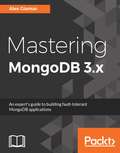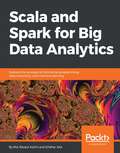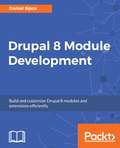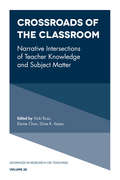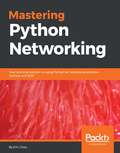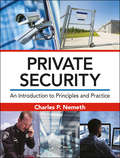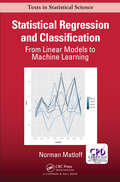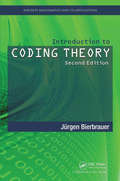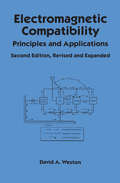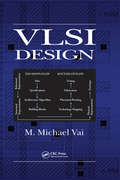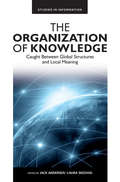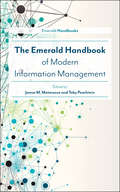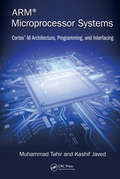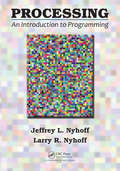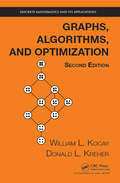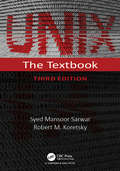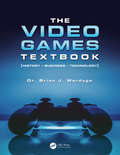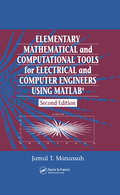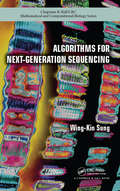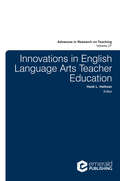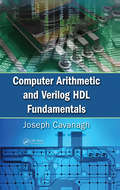- Table View
- List View
Cybersecurity: Geopolitics, Law, and Policy
by Amos N. GuioraThis book examines the legal and policy aspects of cyber-security. It takes a much needed look at cyber-security from a geopolitical perspective. Through this lens, it seeks to broaden the reader's understanding of the legal and political considerations of individuals, corporations, law enforcement and regulatory bodies and management of the complex relationships between them. In drawing on interviews conducted with experts from a wide range of fields, the book presents the reader with dilemmas and paradigms that confront law makers, corporate leaders, law enforcement, and national leaders. The book is structured in a novel format by employing a series of vignettes which have been created as exercises intended to confront the reader with the dilemmas involved in cyber-security. Through the use of vignettes, the work seeks to highlight the constant threat of cyber-security against various audiences, with the overall aim of facilitating discussion and reaction to actual probable events. In this sense, the book seeks to provide recommendations for best practices in response to the complex and numerous threats related to cyber-security. This book will be of interest to students of cyber-security, terrorism, international law, security studies and IR in general, as well as policy makers, professionals and law-enforcement officials.
Python Penetration Testing Cookbook
by Rejah RehimPenetration testing is the use of tools and code to attack a system in order to assess its vulnerabilities to external threats. Python allows pen testers to create their own tools. This book gives quick recipes in Python to let defense analyst work on their own on the vulnerability discovery and recovery path.
Pandas Cookbook
by Theodore PetrouOver 95 hands-on recipes to leverage the power of pandas for efficient scientific computation and data analysis About This Book • Use the power of pandas to solve most complex scientific computing problems with ease • Leverage fast, robust data structures in pandas to gain useful insights from your data • Practical, easy to implement recipes for quick solutions to common problems in data using pandas Who This Book Is For This book is for data scientists, analysts and Python developers who wish to perform data analysis and scientific computing in a practical, hands-on manner. The recipes included in this book are suitable for both novice and advanced users, and contain helpful tips, tricks and caveats wherever necessary. Some understanding of pandas will be helpful, but not mandatory. What You Will Learn • Master the fundamentals of pandas to quickly begin exploring any dataset • Isolate any subset of data by properly selecting and querying the data • Split data into independent groups before applying aggregations and transformations to each group • Restructure data into a tidy form to make data analysis and visualization easier • Prepare messy real-world datasets for machine learning • Combine and merge data from different sources through pandas SQL-like operations • Utilize pandas unparalleled time series functionality • Create beautiful and insightful visualizations through pandas direct hooks to matplotlib and seaborn In Detail Pandas is one of the most powerful, flexible, and efficient scientific computing packages in Python. With this book, you will explore data in pandas through dozens of practice problems with detailed solutions in iPython notebooks. This book will provide you with clean, clear recipes, and solutions that explain how to handle common data manipulation and scientific computing tasks with pandas. You will work with different types of datasets, and perform data manipulation and data wrangling effectively. You will explore the power of pandas DataFrames and find out about boolean and multi-indexing. Tasks related to statistical and time series computations, and how to implement them in financial and scientific applications are also covered in this book. By the end of this book, you will have all the knowledge you need to master pandas, and perform fast and accurate scientific computing. Style and approach This book consists of hands-on recipes where you'll deal with real-world problems. You'll execute a series of tasks as you walk through data science challenges using idiomatic pandas. Your one-stop solution for common and not-so-common pain points, this is a book that you must have on the shelf.
Software-Defined Networking with OpenFlow - Second Edition
by Siamak Azodolmolky Oswald CokerMaster OpenFlow concepts to improve and make your projects efficient with the help of Software-Defined Networking. About This Book • Master the required platforms and tools to build network applications with OpenFlow • Get to grips with the updated OpenFlow and build robust SDN-based solutions • An end-to-end thorough overview of open-source switches, controllers, and tools Who This Book Is For If you are a network/system administrator or a system engineer and would like to implement OpenFlow concepts and take Software-Defined Networking on your projects to the next level, then this book is for you. If you are aware of broad networking concepts, and are familiar with the day-to-day operation of computer networks, you will find this book very beneficial. What You Will Learn • Explore Software-Defined Networking and activities around SDN/OpenFlow including OpenFlow messages • Hardware and software implementations of OpenFlow switches and experiment with Mininet GUI • Learn about the role of OpenFlow in cloud computing by configuring and setting up the Neutron and Floodlight OpenFlow controller plugins • Simulate and test utilities, and familiarize yourself with OpenFlow soft switches, controllers, virtualization, and orchestration tools • Enhance and build environments for Net App development by installing VM's and tools such as Mininet and Wireshark • Learn about hardware and software switches and get a feel for active open-source projects around SDN and OpenFlow In Detail OpenFlow paves the way for an open, centrally programmable structure, thereby accelerating the effectiveness of Software-Defined Networking. Software-Defined Networking with OpenFlow, Second Edition takes you through the product cycle and gives you an in-depth description of the components and options that are available at each stage. The aim of this book is to help you implement OpenFlow concepts and improve Software-Defined Networking on your projects. You will begin by learning about building blocks and OpenFlow messages such as controller-to-switch and symmetric and asynchronous messages. Next, this book will take you through OpenFlow controllers and their existing implementations followed by network application development. Key topics include the basic environment setup, the Neutron and Floodlight OpenFlow controller, XORPlus OF13SoftSwitch, enterprise and affordable switches such as the Zodiac FX and HP2920. By the end of this book, you will be able to implement OpenFlow concepts and improve Software-Defined Networking in your projects. Style and approach This book is an easy-to-follow and pragmatic guide networking. Each topic adopts a logical approach and provides hints to help you build and deliver SDN Solutions efficiently.
Mastering MongoDB 3.x
by Alex GiamasAn expert's guide to building fault-tolerant MongoDB applications
Scala and Spark for Big Data Analytics: Explore the concepts of functional programming, data streaming, and machine learning
by Md. Rezaul Karim Sridhar AllaHarness the power of Scala to program Spark and analyze tonnes of data in the blink of an eye! About This Book • Learn Scala's sophisticated type system that combines Functional Programming and object-oriented concepts • Work on a wide array of applications, from simple batch jobs to stream processing and machine learning • Explore the most common as well as some complex use-cases to perform large-scale data analysis with Spark Who This Book Is For Anyone who wishes to learn how to perform data analysis by harnessing the power of Spark will find this book extremely useful. No knowledge of Spark or Scala is assumed, although prior programming experience (especially with other JVM languages) will be useful to pick up concepts quicker. What You Will Learn • Understand object-oriented & functional programming concepts of Scala • In-depth understanding of Scala collection APIs • Work with RDD and DataFrame to learn Spark's core abstractions • Analysing structured and unstructured data using SparkSQL and GraphX • Scalable and fault-tolerant streaming application development using Spark structured streaming • Learn machine-learning best practices for classification, regression, dimensionality reduction, and recommendation system to build predictive models with widely used algorithms in Spark MLlib & ML • Build clustering models to cluster a vast amount of data • Understand tuning, debugging, and monitoring Spark applications • Deploy Spark applications on real clusters in Standalone, Mesos, and YARN In Detail Scala has been observing wide adoption over the past few years, especially in the field of data science and analytics. Spark, built on Scala, has gained a lot of recognition and is being used widely in productions. Thus, if you want to leverage the power of Scala and Spark to make sense of big data, this book is for you. The first part introduces you to Scala, helping you understand the object-oriented and functional programming concepts needed for Spark application development. It then moves on to Spark to cover the basic abstractions using RDD and DataFrame. This will help you develop scalable and fault-tolerant streaming applications by analyzing structured and unstructured data using SparkSQL, GraphX, and Spark structured streaming. Finally, the book moves on to some advanced topics, such as monitoring, configuration, debugging, testing, and deployment. You will also learn how to develop Spark applications using SparkR and PySpark APIs, interactive data analytics using Zeppelin, and in-memory data processing with Alluxio. By the end of this book, you will have a thorough understanding of Spark, and you will be able to perform full-stack data analytics with a feel that no amount of data is too big. Style and approach Filled with practical examples and use cases, this book will hot only help you get up and running with Spark, but will also take you farther down the road to becoming a data scientist.
Drupal 8 Module Development
by Daniel SiposLearn to create and customize impressive Drupal 8 modules to extend your website's functionalities About This Book • Unleash the power of Drupal 8 programming by creating efficient modules and extensions • Explore a plethora of Drupal 8 APIs and get the best out of them using the power of PHP coding • Learn to implement efficient data management and data security by creating dedicated modules for it. Who This Book Is For The primary target of this book is Drupal developers who want to learn how to write modules and carry out development in Drupal 8. It is also intended for Drupal site builders and PHP developers who have basic Object Oriented Programming skills. A little bit of Symfony experience is helpful but not mandatory. What You Will Learn • Write a Drupal 8 module with custom functionality and hook into various extension points • Master numerous Drupal 8 sub-systems and APIs • Model, store, and manipulate data in various ways and for various purposes • Display data and content in a presentable and secure way • Learn about the theme system and render arrays In Detail Drupal is an open source web-based content management system (CMS) that can be used for building anything from simple websites to complex applications. It enables individuals and organizations to build platforms that engage users and deliver the right content at the right time. Drupal 8 is an exciting new development in the Drupal community. However, the differences from the previous version are substantial and this can put quite some pressure on Drupal 7 developers that need to catch up. This book aims to help such developers in getting up to speed with Drupal 8 module development. The book first introduces you to the Drupal 8 architecture and its subsystems before diving into creating your first module with basic functionality. Building upon that, you will cover many core APIs and functionalities available to module developers. You will work with the Drupal logging and mailing systems, learn how to output data using the theme layer and work with menus and links programmatically. Then, you will learn how to work with different kinds of data storages, create custom entities, field types and leverage the Database API for lower level database queries. Moreover, you will learn about the Drupal 8 access system and caching layer as well as the APIs used for data processing (queues and batches). You will further see how to introduce javascript into your module, work with the various file systems and ensure the code you write works on multilingual sites. Finally, you will learn how to programmatically work with Views, write automated tests for your functionality and also write secure code in general. By the end of the book, you will have learned how to develop your own custom module from scratch that can help solve a small problem or even provide complex functionality. And who knows, maybe you'll even contribute it back to the Drupal community. Style and approach This book aims to introduce PHP developers to programming concepts specific to Drupal 8 to get them started on writing their own functionality with Drupal 8 and create efficient Drupal 8 modules and extensions.
Crossroads of the Classroom: Narrative Intersections of Teacher Knowledge and Subject Matter (Advances in Research on Teaching #28)
by Vicki Ross Elaine Chan Dixie K. KeyesThis book aims to explore and make visible the intersection of subject matter knowledge and teacher knowledge in the narratives of teachers. This complicated interaction between these two bodies of knowledge is often studied and little understood. This book uses narrative to examine the complexities of teaching and learning. The authors of the chapters, as well as the editors, use innovative approaches to narrative methodology for research on teaching and teacher education in areas of education critical to teachers’ lives. Particularly through this book, they continue to advance the work of researchers to display narratives of educator lives and ways of knowing while opening the space for a community of narrative scholars.
Mastering Python Networking: Your one stop solution to using Python for network automation, DevOps, and SDN
by Eric ChouBecome an expert in implementing advanced, network-related tasks with Python. About This Book • Build the skills to perform all networking tasks using Python with ease • Use Python for network device automation, DevOps, and software-defined networking • Get practical guidance to networking with Python Who This Book Is For If you are a network engineer or a programmer who wants to use Python for networking, then this book is for you. A basic familiarity with networking-related concepts such as TCP/IP and a familiarity with Python programming will be useful. What You Will Learn • Review all the fundamentals of Python and the TCP/IP suite • Use Python to execute commands when the device does not support the API or programmatic interaction with the device • Implement automation techniques by integrating Python with Cisco, Juniper, and Arista eAPI • Integrate Ansible using Python to control Cisco, Juniper, and Arista networks • Achieve network security with Python • Build Flask-based web-service APIs with Python • Construct a Python-based migration plan from a legacy to scalable SDN-based network. In Detail This book begins with a review of the TCP/ IP protocol suite and a refresher of the core elements of the Python language. Next, you will start using Python and supported libraries to automate network tasks from the current major network vendors. We will look at automating traditional network devices based on the command-line interface, as well as newer devices with API support, with hands-on labs. We will then learn the concepts and practical use cases of the Ansible framework in order to achieve your network goals. We will then move on to using Python for DevOps, starting with using open source tools to test, secure, and analyze your network. Then, we will focus on network monitoring and visualization. We will learn how to retrieve network information using a polling mechanism, ?ow-based monitoring, and visualizing the data programmatically. Next, we will learn how to use the Python framework to build your own customized network web services. In the last module, you will use Python for SDN, where you will use a Python-based controller with OpenFlow in a hands-on lab to learn its concepts and applications. We will compare and contrast OpenFlow, OpenStack, OpenDaylight, and NFV. Finally, you will use everything you've learned in the book to construct a migration plan to go from a legacy to a scalable SDN-based network. Style and approach An easy-to-follow guide packed with hands-on examples of using Python for network device automation, DevOps, and SDN.
Private Security: An Introduction to Principles and Practice
by Charles P. NemethThere are few textbooks available that outline the foundation of security principles while reflecting the modern practices of private security as an industry. Private Security: An Introduction to Principles and Practice takes a new approach to the subject of private sector security that will be welcome addition to the field. The book focuses on the recent history of the industry and the growing dynamic between private sector security and public safety and law enforcement. Coverage will include history and security theory, but emphasis is on current practice, reflecting the technology-driven, fast-paced, global security environment. Such topics covered include a history of the security industry, security law, risk management, physical security, Human Resources and personnel, investigations, institutional and industry-specific security, crisis and emergency planning, critical infrastructure protection, IT and computer security, and more. Rather than being reduced to single chapter coverage, homeland security and terrorism concepts are referenced throughout the book, as appropriate. Currently, it vital that private security entities work with public sector authorities seamlessly—at the state and federal levels—to share information and understand emerging risks and threats. This modern era of security requires an ongoing, holistic focus on the impact and implications of global terror incidents; as such, the book’s coverage of topics consciously takes this approach throughout. Highlights include: Details the myriad changes in security principles, and the practice of private security, particularly since 9/11 Focuses on both foundational theory but also examines current best practices—providing sample forms, documents, job descriptions, and functions—that security professionals must understand to perform and succeed Outlines the distinct, but growing, roles of private sector security companies versus the expansion of federal and state law enforcement security responsibilities Includes key terms, learning objectives, end of chapter questions, Web exercises, and numerous references—throughout the book—to enhance student learning Presents the full range of career options available for those looking entering the field of private security Includes nearly 400 full-color figures, illustrations, and photographs. Private Security: An Introduction to Principles and Practice provides the most comprehensive, up-to-date coverage of modern security issues and practices on the market. Professors will appreciate the new, fresh approach, while students get the most "bang for their buck," insofar as the real-world knowledge and tools needed to tackle their career in the ever-growing field of private industry security. An instructor’s manual with Exam questions, lesson plans, and chapter PowerPoint® slides are available upon qualified course adoption.
Statistical Regression and Classification: From Linear Models to Machine Learning (Chapman & Hall/CRC Texts in Statistical Science)
by Norman MatloffStatistical Regression and Classification: From Linear Models to Machine Learning takes an innovative look at the traditional statistical regression course, presenting a contemporary treatment in line with today's applications and users. The text takes a modern look at regression: * A thorough treatment of classical linear and generalized linear models, supplemented with introductory material on machine learning methods. * Since classification is the focus of many contemporary applications, the book covers this topic in detail, especially the multiclass case. * In view of the voluminous nature of many modern datasets, there is a chapter on Big Data. * Has special Mathematical and Computational Complements sections at ends of chapters, and exercises are partitioned into Data, Math and Complements problems. * Instructors can tailor coverage for specific audiences such as majors in Statistics, Computer Science, or Economics. * More than 75 examples using real data. The book treats classical regression methods in an innovative, contemporary manner. Though some statistical learning methods are introduced, the primary methodology used is linear and generalized linear parametric models, covering both the Description and Prediction goals of regression methods. The author is just as interested in Description applications of regression, such as measuring the gender wage gap in Silicon Valley, as in forecasting tomorrow's demand for bike rentals. An entire chapter is devoted to measuring such effects, including discussion of Simpson's Paradox, multiple inference, and causation issues. Similarly, there is an entire chapter of parametric model fit, making use of both residual analysis and assessment via nonparametric analysis. Norman Matloff is a professor of computer science at the University of California, Davis, and was a founder of the Statistics Department at that institution. His current research focus is on recommender systems, and applications of regression methods to small area estimation and bias reduction in observational studies. He is on the editorial boards of the Journal of Statistical Computation and the R Journal. An award-winning teacher, he is the author of The Art of R Programming and Parallel Computation in Data Science: With Examples in R, C++ and CUDA.
Introduction to Coding Theory (Discrete Mathematics and Its Applications)
by Jurgen BierbrauerThis book is designed to be usable as a textbook for an undergraduate course or for an advanced graduate course in coding theory as well as a reference for researchers in discrete mathematics, engineering and theoretical computer science. This second edition has three parts: an elementary introduction to coding, theory and applications of codes, and algebraic curves. The latter part presents a brief introduction to the theory of algebraic curves and its most important applications to coding theory.
Electromagnetic Compatibility: Principles and Applications, Second Edition, Revised and Expanded (Electrical and Computer Engineering)
by David WestonThis totally revised and expanded reference/text provides comprehensive, single-source coverage of the design, problem solving, and specifications of electromagnetic compatibility (EMC) into electrical equipment/systems-including new information on basic theories, applications, evaluations, prediction techniques, and practical diagnostic options for preventing EMI through cost-effective solutions.Offers the most recent guidelines, safety limits, and standards for human exposure to electromagnetic fields!Containing updated data on EMI diagnostic verification measurements, as well as over 900 drawings, photographs, tables, and equations-500 more than the previous edition-Electromagnetic Compatibility: Principles and Applications, Second Edition:
VLSI Design (VLSI Circuits)
by M. Michael VaiVery Large Scale Integration (VLSI) has become a necessity rather than a specialization for electrical and computer engineers. This unique text provides Engineering and Computer Science students with a comprehensive study of the subject, covering VLSI from basic design techniques to working principles of physical design automation tools to leading edge application-specific array processors.Beginning with CMOS design, the author describes VLSI design from the viewpoint of a digital circuit engineer. He develops physical pictures for CMOS circuits and demonstrates the top-down design methodology using two design projects - a microprocessor and a field programmable gate array. The author then discusses VLSI testing and dedicates an entire chapter to the working principles, strengths, and weaknesses of ubiquitous physical design tools. Finally, he unveils the frontiers of VLSI. He emphasizes its use as a tool to develop innovative algorithms and architecture to solve previously intractable problems.VLSI Design answers not only the question of "what is VLSI," but also shows how to use VLSI. It provides graduate and upper level undergraduate students with a complete and congregated view of VLSI engineering.
The Organization of Knowledge: Caught Between Global Structures and Local Meaning (Studies in Information #12)
by Jack Andersen Associate Professor Laura SkouvigThis book critically examines the organization of knowledge as it is involved in matters of digital communication, the social, cultural and political consequences of classifying, and how particular historical contexts shape ideas of information and what information to classify and record. Due to permeation of digital infrastructures, software, and digital media in everyday life, many aspects of contemporary culture and society are infused with the activity and practice of classification. That means that old questions about classification have their potency in modern discourses about surveillance, identify formation, big data and so on. At the same time, this situation also implies a need to reconsider these old questions and how to frame them in digital culture. This book contains contributions that consider classic library classification practices and how their choices have social, cultural and political effect, how the organization of knowledge is not only a professional practice but is also a way of communicating and understanding digital culture, and how what a particular historical context perceives as information has implications for the recording of that information.
The Emerald Handbook of Modern Information Management
by Dr James M. Matarazzo Dr Toby PearlsteinAward-winning information theorists and practitioners Pearlstein and Matarazzo have assembled a group of top international authors with experience in public, academic, government, and special library settings, including experienced independent information professionals, to address the critical issues facing Information Management (IM) today. This new handbook provides a context for approaching the world in which information professionals work; a tool, the Balanced Scorecard, to help demonstrate contribution and value; and a review of opportunities for new areas of employment and career development, ripe for applying the Information Services skill set. Through combinations of topical chapters with common themes, the professor and student will find a multi-perspective approach to the IM landscape. Used as a ready-reference, the IM practitioner will find both theoretical and pragmatic approaches to inform their decision making on traditional as well as new challenges. For information and IM professionals, librarians, and students, this must-have handbook provides invaluable insights from the leading names in the field, enabling you to make the best decision no matter what challenges you face.
ARM Microprocessor Systems: Cortex-M Architecture, Programming, and Interfacing
by Muhammad Tahir Kashif JavedThis book presents the use of a microprocessor-based digital system in our daily life. Its bottom-up approach ensures that all the basic building blocks are covered before the development of a real-life system. The ultimate goal of the book is to equip students with all the fundamental building blocks as well as their integration, allowing them to implement the applications they have dreamed up with minimum effort.
Processing: An Introduction to Programming
by Jeffrey L. Nyhoff Larry R. NyhoffThis book demonstrates how Processing is an excellent language for beginners to learn the fundamentals of computer programming. Originally designed to make it simpler for digital artists to learn to program, Processing is a wonderful first language for anyone to learn. Given its origins, Processing enables a multimodal approach to programming instruction, well suited to students with interests in computer science or in the arts and humanities. The book uses Processing’s capabilities for graphics and interactivity in order to create examples that are simple, illustrative, interesting, and fun. It is designed to appeal to a broad range of readers, including those who want to learn to program to create digital art, as well as those who seek to learn to program to process numerical information or data. It can be used by students and instructors in a first course on programming, as well as by anyone eager to teach them self to program. Following a traditional sequence of topics for introducing programming, the book introduces key computer science concepts, without overwhelming readers with extensive detail. Additional exercises are available, as are other supplementary materials for instructors looking to introduce even more computer science concepts associated with the topics. Several online chapters are also provided that introduce slightly more advanced topics in Processing, such as two-dimensional arrays, manipulation of strings, and file input and output. The conversational style and pace of the book are based upon the authors’ extensive experience with teaching programming to a wide variety of beginners in a classroom. No prior programming experience is expected.
Graphs, Algorithms, and Optimization (Discrete Mathematics and Its Applications)
by William Kocay Donald L. KreherThe second edition of this popular book presents the theory of graphs from an algorithmic viewpoint. The authors present the graph theory in a rigorous, but informal style and cover most of the main areas of graph theory. The ideas of surface topology are presented from an intuitive point of view. We have also included a discussion on linear programming that emphasizes problems in graph theory. The text is suitable for students in computer science or mathematics programs.
UNIX: The Textbook, Third Edition
by Syed Mansoor Sarwar Robert M. KoretskyUNIX: The Textbook, Third Edition provides a comprehensive introduction to the modern, twenty-first-century UNIX operating system. The book deploys PC-BSD and Solaris, representative systems of the major branches of the UNIX family, to illustrate the key concepts. It covers many topics not covered in older, more traditional textbook approaches, such as Python, UNIX System Programming from basics to socket-based network programming using the client-server paradigm, the Zettabyte File System (ZFS), and the highly developed X Windows-based KDE and Gnome GUI desktop environments. The third edition has been fully updated and expanded, with extensive revisions throughout. It features a new tutorial chapter on the Python programming language and its use in UNIX, as well as a complete tutorial on the git command with Github. It includes four new chapters on UNIX system programming and the UNIX API, which describe the use of the UNIX system call interface for file processing, process management, signal handling, interprocess communication (using pipes, FIFOs, and sockets), extensive coverage of internetworking with UNIX TCP/IP using the client-server software, and considerations for the design and implementation of production-quality client-server software using iterative and concurrent servers. It also includes new chapters on UNIX system administration, ZFS, and container virtualization methodologies using iocage, Solaris Jails, and VirtualBox. Utilizing the authors’ almost 65 years of practical teaching experience at the college level, this textbook presents well-thought-out sequencing of old and new topics, well-developed and timely lessons, a Github site containing all of the code in the book plus exercise solutions, and homework exercises/problems synchronized with the didactic sequencing of chapters in the book. With the exception of four chapters on system programming, the book can be used very successfully by a complete novice, as well as by an experienced UNIX system user, in both an informal and formal learning environment. The book may be used in several computer science and information technology courses, including UNIX for beginners and advanced users, shell and Python scripting, UNIX system programming, UNIX network programming, and UNIX system administration. It may also be used as a companion to the undergraduate and graduate level courses on operating system concepts and principles.
The Video Games Textbook: History • Business • Technology
by Brian J. WardygaThe Video Games Textbook takes the history of video games to another level, with visually-stimulating, comprehensive, and chronological chapters that are relevant and easy to read for a variety of students. Every chapter is a journey into a different era or area of gaming, where readers emerge with a strong sense of how video games evolved, why they succeeded or failed, and the impact they had on the industry and human culture. Written to capture the attention and interest of both domestic and international college students, each chapter contains a list of objectives and key terms, illustrative timelines, arcade summaries, images and technical specifications of all major consoles.
Elementary Mathematical and Computational Tools for Electrical and Computer Engineers Using MATLAB
by Jamal T. ManassahEngineers around the world depend on MATLAB for its power, usability, and outstanding graphics capabilities. Yet too often, engineering students are either left on their own to acquire the background they need to use MATLAB, or they must learn the program concurrently within an advanced course. Both of these options delay students from solving realistic design problems, especially when they do not have a text focused on applications relevant to their field and written at the appropriate level of mathematics.Ideal for use as a short-course textbook and for self-study Elementary Mathematical and Computational Tools for Electrical and Computer Engineers Using MATLAB fills that gap. Accessible after just one semester of calculus, it introduces the many practical analytical and numerical tools that are essential to success both in future studies and in professional life. Sharply focused on the needs of the electrical and computer engineering communities, the text provides a wealth of relevant exercises and design problems. Changes in MATLAB's version 6.0 are included in a special addendum.The lack of skills in fundamental quantitative tools can seriously impede progress in one's engineering studies or career. By working through this text, either in a lecture/lab environment or by themselves, readers will not only begin mastering MATLAB, but they will also hone their analytical and computational skills to a level that will help them to enjoy and succeed in subsequent electrical and computer engineering pursuits.
Algorithms for Next-Generation Sequencing (Chapman & Hall/CRC Computational Biology Series)
by Wing-Kin SungAdvances in sequencing technology have allowed scientists to study the human genome in greater depth and on a larger scale than ever before – as many as hundreds of millions of short reads in the course of a few days. But what are the best ways to deal with this flood of data? Algorithms for Next-Generation Sequencing is an invaluable tool for students and researchers in bioinformatics and computational biology, biologists seeking to process and manage the data generated by next-generation sequencing, and as a textbook or a self-study resource. In addition to offering an in-depth description of the algorithms for processing sequencing data, it also presents useful case studies describing the applications of this technology.
Innovations in English Language Arts Teacher Education (Advances in Research on Teaching #27)
by Stefinee E. Pinnegar Heidi L. HallmanChanges in the discipline of english language arts teacher education have produced a much more expansive understanding of literacy and of what teachers of English language arts do. This volume addresses these changes by featuring innovation—both theoretical and applied—in the field itself. Changes in the field of English language arts teacher education suggest a need to also examine how teachers approach learning to teach in a field that has so quickly evolved. This book seeks to understand how a future teaching force will approach this changing landscape and how we, as English teacher educators, might effectively prepare them to do so.
Computer Arithmetic and Verilog HDL Fundamentals
by Joseph CavanaghVerilog Hardware Description Language (HDL) is the state-of-the-art method for designing digital and computer systems. Ideally suited to describe both combinational and clocked sequential arithmetic circuits, Verilog facilitates a clear relationship between the language syntax and the physical hardware. It provides a very easy-to-learn and practical means to model a digital system at many levels of abstraction. Computer Arithmetic and Verilog HDL Fundamentals details the steps needed to master computer arithmetic for fixed-point, decimal, and floating-point number representations for all primary operations. Silvaco International’s SILOS, the Verilog simulator used in these pages, is simple to understand, yet powerful enough for any application. It encourages users to quickly prototype and de-bug any logic function and enables single-stepping through the Verilog source code. It also presents drag-and-drop abilities. Introducing the three main modeling methods—dataflow, behavioral, and structural—this self-contained tutorial— Covers the number systems of different radices, such as octal, decimal, hexadecimal, and binary-coded variations Reviews logic design fundamentals, including Boolean algebra and minimization techniques for switching functions Presents basic methods for fixed-point addition, subtraction, multiplication, and division, including the use of decimals in all four operations Addresses floating-point addition and subtraction with several numerical examples and flowcharts that graphically illustrate steps required for true addition and subtraction for floating-point operands Demonstrates floating-point division, including the generation of a zero-biased exponent Designed for electrical and computer engineers and computer scientists, this book leaves nothing unfinished, carrying design examples through to completion. The goal is practical proficiency. To this end, each chapter includes problems of varying complexity to be designed by the reader.
